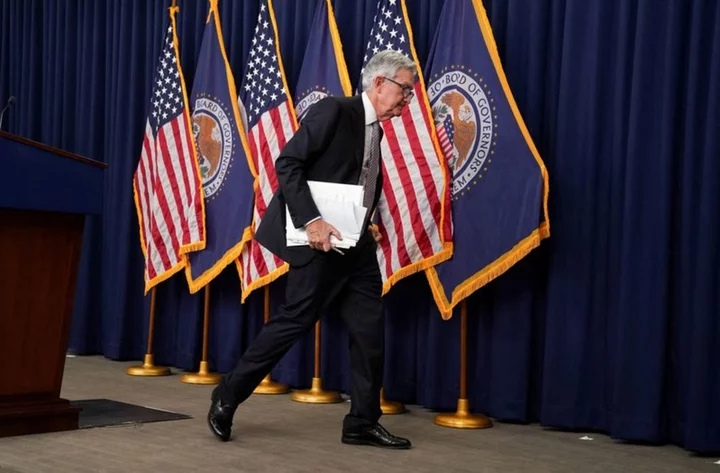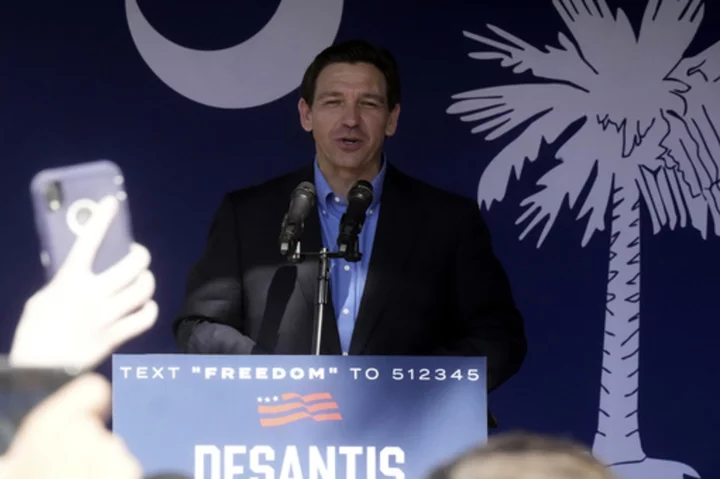By Howard Schneider
WASHINGTON (Reuters) -Federal Reserve officials may still be fighting an inflation war, but they opened the door at their May policy meeting to the possibility the U.S. central bank's benchmark overnight interest rate won't rise from the current 5.00%-5.25% range.
They now have until their next meeting on June 13-14 to choose whether to walk through that door, with upcoming data on jobs, inflation, credit conditions and the health of the banking system informing the decision and public comments from Fed officials shaping the debate.
Here's a guide:
RETAIL SALES: Current release on May 16
Retail sales rose 0.4% in April, below the 0.8% expected by economists in a Reuters poll, and the prior month's data was revised down. But so-called core sales showed a larger-than-expected 0.7% increase, indicating consumption remains strong. Fed officials at this point give a textbook economics explanation for inflation, blaming it on a mismatch between supply and demand. Regardless of which side of the equation is more to blame, monetary policy at least in the short run works to curb spending - and the more it expands, the more Fed officials may feel interest rates need to move higher.
INFLATION: Current release on May 10, next release on May 26
Consumer price inflation eased slightly in April to a 4.9% annual rate from 5% in March, with underlying "core" prices excluding food and energy increasing 5.5% versus 5.6% in the prior month. That's still high. But much of the headline number came from housing, where the Fed feels certain that inflation will ease, while some of the "stickier" service price components seem to be cooling.
Investors and analysts took the report on the whole as supporting a pause in the Fed rate increases at the June meeting. The central bank will get its next inflation reading on May 26 when the Personal Consumption Expenditures price index for April is released. The PCE, which is the Fed's preferred gauge for its 2% inflation target, has been running at more than twice that level. The CPI report covering May will be released on June 13.
JOBS: Current release on May 5, next release on June 2
April jobs growth came in stronger than expected, with the economy adding 253,000 positions across a broad set of industries, and wage growth remaining at a robust 4.4% annual rate. The May employment report will be released on June 2. Employment gains, from the central bank's perspective, have been unsustainably strong, with officials looking for the pace of monthly job creation to slow or even turn negative, and "softness" in the labor market seen as part of what's needed to lower inflation. Continued readings like the ones in April could weaken the case for pausing rate hikes.
JOB OPENINGS: Next release on May 31
The Job Openings and Labor Turnover Survey, or JOLTS, became an important series for the Fed during the COVID-19 pandemic for its insight on labor market dynamics, including the rate at which workers are quitting - a sign of employee leverage and tight markets - and the number of open jobs - a sign of company demand for employees. Fed Chair Jerome Powell paid particular attention to last year's record high of two open jobs for each unemployed job seeker, a pandemic-era peculiarity that has been easing.
BANK DATA: Released every Thursday and Friday
To some degree the Fed wants credit to become more expensive and less available. That's how increases in its policy rate influence economic activity. But it doesn't want financial conditions to tighten more than necessary, and recent bank failures threatened both broader stress in the industry and a worse-than-anticipated credit crunch. Weekly data on bank lending to customers, and Fed lending to banks, show loan growth is slowing and borrowing by banks remains elevated.
FEDSPEAK: Ongoing
The Fed's internal communications rules set a "blackout" period around each policy meeting. U.S. central bank officials will be able to speak publicly about their policy views through June 2.
Fed Chair Jerome Powell, May 19: "Our guidance is limited to identifying the factors we'll be monitoring as we assess the extent to which additional policy firming may be appropriate to return inflation to 2%."
Fed Governor Philip Jefferson, May 18: "History shows that monetary policy works with long and variable lags, and that a year is not a long enough period for demand to feel the full effect of higher interest rates."
Minneapolis Fed President Neel Kashkari, May 22: "I think right now, it's a close call either way, versus raising another time in June or skipping," Kashkari said, adding that "important to me is not signaling that we're done."
St. Louis Fed President James Bullard, May 22: Bullard said rates may need to rise by another half of a percentage point this year. "The risk with inflation is that it does not turn around and go back to a low level ... As long as the labor market is so good, it is a great time to get this problem behind us and not replay the 1970s."
San Francisco Fed President Mary Daly, May 22: Daly said it is too soon to say what the Fed will do at the June meeting. "We have to be extremely data-dependent."
Dallas Fed President Lorie Logan, May 18: "The data in coming weeks could yet show that it is appropriate to skip a meeting ... As of today, though, we aren't there yet."
Richmond Fed President Thomas Barkin, May 16: "You could tell yourself a story where inflation comes down relatively quickly ... with only a modest economic slowdown ... I'm not yet convinced."
Atlanta Fed President Raphael Bostic, May 16: Businesses "are telling me 'we think you're close to overdoing it' ... There's a long history of the Federal Reserve overshooting their policy and driving the economy into a more negative place. I would rather avoid that if we can."
New York Fed President John Williams, May 8: "We haven't said we are done raising rates ... If additional policy firming is appropriate, we'll do that."
Chicago Fed President Austan Goolsbee, May 5: "We know that credit conditions like the ones we are seeing now in the past have been correlated with recessions, credit crunches," Goolsbee said. "It's way too premature to know what to do with monetary policy."
(Reporting by Howard Schneider;Editing by Dan Burns, Andrea Ricci and Paul Simao)









